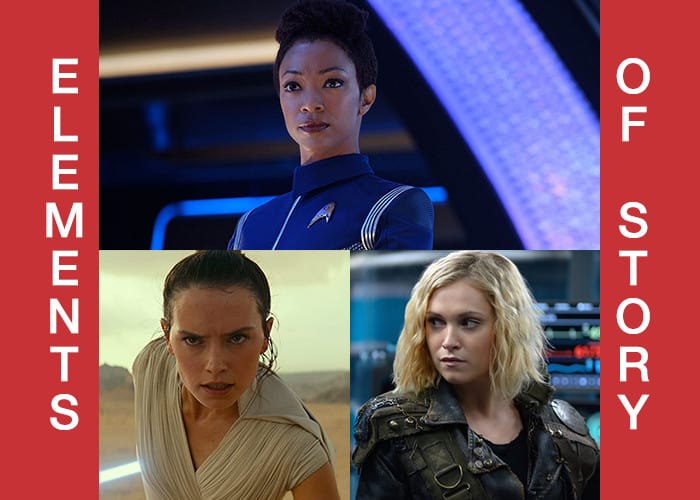Welcome to Elements of Story, a biweekly column about narrative tropes, what they mean, and why they just won’t go away.
The concept of the “strong female character,” or SFC, has kept a steady presence in pop culture discourse for at least the better part of a decade, but it’s aging about as well as raw meat left out in direct sunlight. Posited as the answer to frustrations over the dearth of lead roles for women and cardboard-cutout supporting damsels in distress lacking any sense of agency or interiority, the SFC, in practice, has presented more of a step sideways than forwards. As a growing number of commentators (including actress and screenwriter Brit Marling in a New York Times op-ed published in February 2020) have noted that the SFC, while a refreshing change of pace at first, has now just become the new face of the issue it purportedly seeks to address—the proliferation of stereotypical, flat-to-the-point-of-dehumanization female characters on screen.
Where once the predominant character stereotypes for women were an amalgamation of traits traditionally deemed feminine—the textbook damsel in distress and femme fatal, or, in academic lingo, the Madonna-Whore dichotomy—the prevailing variant of SFC goes to the opposite extreme and embodies stereotypically masculine traits. She kicks ass and takes names, often in stilettos, and don’t bother wasting her time with “feelings.” If it’s the sort of story to feature adult content, odds are the SFC’s the type to sleep around, no strings attached—because that, as most movies will tell you, is the one and only possible answer to the question of what empowered female sexuality looks like. As Marling notes in her article, “what we really mean when we say we want strong female leads is: ‘Give me a man but in the body of a woman I still want to see naked.'”
If we set aside gender politics and the role of misogyny (and various other considerations that are relevant to the broader discussion of this issue, but are tangential to the focus of this column), the problem with the SFC (and other overplayed female archetypes) is that they try to reduce the art of character building to a simple formula: add this trait and that trait in desired quantities, a pinch of an acceptable flaw for depth, stir to combine. Building a strong character—that is, strong as in nuanced, compelling, and memorable; not as in able to bench press a tank—is not the sort of thing that can be effectively treated like following a recipe. The human mind is incredibly adept at picking up patterns—a cookie-cutter approach will produce characters that inevitably feel like cutout cookies, not people. Swapping out stereotypically feminine traits for stereotypically masculine traits, which is the fundamental innovation at the heart of the SFC trend, goes from one extreme to the other without addressing this basic problem. The one thing it does do is represent a collective response that posits moving from stereotypically feminine to masculine as representing “progress” or improvement, indicating certain cultural biases against femininity that definitely warrant further discussion, but I digress.
One of the least discussed but most apparent indicators of the SFC’s true nature as a masculinized pool of tropes, as opposed to a more genuinely thoughtful approach to crafting female characters, is right there in the name—or more accurately, a prominent naming trend. Particularly in the realm of sci-fi, where creatives play in the sandbox of truly infinite possibilities (it’s not like most pay any regard to the laws of physics or other scientific realities after all), it’s become notably fashionable over the past few years to bestow female leads with names that aren’t just familiar, but traditionally masculine. Rey (Daisy Ridley) of the Star Wars sequel trilogy might be spelled with an “e” as opposed to an “a,” but it still sounds like the perennially popular boy’s name—and the “e” also makes her name the Spanish word for “king,” which just in case it isn’t clear, is a masculine noun (el rey). The star of the CW’s post-apocalyptic sci-fi drama The 100, is none other than a young woman named Clarke Griffin (Eliza Taylor). The first of the CBS All Access Star Trek series, Star Trek: Discovery, focuses on the adventures of the ship’s science specialist Michael Burnham (Sonequa Martin-Green). Alfonso Cuarón’s Oscar-winning film Gravity stars Sandra Bullock as medical engineer Ryan Stone. Christopher Nolan’s tale of wormholes and unbreakable father-daughter bonds Interstellar features Jessica Chastain as scientist Murphy Cooper. The list goes on.
To be clear, giving women traditionally masculine names is not in itself an issue. It’s even something of a trend in the real world (see: Ryan Reynolds and Blake Lively’s daughter, James). It’s also worth noting that on occasion, these female characters with masculine names are the result of characters initially written for men being cast as women as opposed to intentionally bestowing female characters with masculine names. In any case, while no single incidence of this naming quirk is an issue, the overall trend does raise questions worth mulling. Particularly, why the demand for treating female characters more like actual people has resulted in a markedly increased supply of female characters who act more like stereotypical men, and are often even named accordingly.

